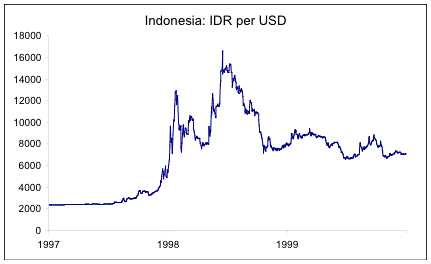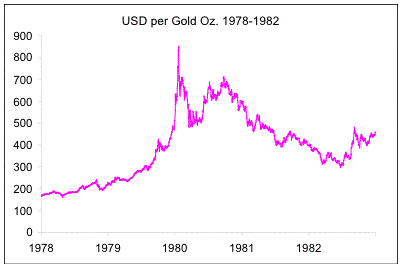Is Gold an Investment?
December 30, 2005
Barron’s last week began to take notice of the bull market in gold vs. the dollar. “There have been myriad theories for the surge in the misunderstood metal, which is variously described as a currency, a commodity, an inflation hedge and an asset class,” Barron’s wrote, hinting at a bit of confusion.
Gold is a currency, a commodity, an inflation hedge, and an asset class. It is not, however, an investment.
Gold, quite simply, is money. Its primary defining characteristic is that it is stable in value, which is why it remains a form of money today. Owning gold bullion is a lot like owning a coffee can of $20 bills. We assume that $20 bills will be stable in value, because that is the purpose money is supposed to serve. This is often a bad assumption. We also assume that gold will remain stable in value — and, I would assert, that gold has done exactly this for over 5000 years.
Thus, it is easy to see that gold is a “currency.” It is undoubtedly a commodity. Since inflation is a decline in value of a currency, gold naturally “hedges” against inflationary events. It can be considered an asset class, in the same way that “cash” (i.e. short-term dollar-denominated loans) is often considered an asset class. I note that “gold mining” is considered its own sector of the S&P 500, while all other forms of mining are in a different sector.
OK, so what is an investment? The defining characteristic of an investment is that it produces cash flow–or has the potential to produce cash flow in the future. This cash flow increases the value of the original investment. An investment’s value is not stable. It is expected to increase. Obviously, an investment is not money, although, like a loan, it might be defined in money terms. A gold-denominated loan can be an investment. Virtually all loans were gold-denominated a hundred years ago. But then, you have counterparty risk, currency risk, and liquidity preference — no access to your funds until maturity. A gold-denominated loan is not money.
It is not hard to see that the only situation in which gold is a superior asset is one in which the value of everything else declines. If there is no credit risk (as with government bills perhaps), then “cash” would be a superior alternative to gold if the currency itself is stable in value, as “cash” pays some interest. Since there are many currencies in which one can hold short-term “cash,” the only situation in which gold is a superior asset is one in which currencies around the world lose value, as expressed by their declining exchange value versus gold. (I put “cash” in quotes because these are really short-term, interest-paying loans, with counterparty and default risk. Real cash — bundles of $20 bills — does not pay interest.)
In practice, when the world’s primary currency loses value significantly, it is all-but-impossible for other currencies not to follow it lower. This was true in the 1930s, when Britain began a worldwide cycle of devaluation, and it was true in the 1970s, when the US began a worldwide cycle of devaluation. The reason for this is simply that other countries cannot bear the effects of exchange rate changes caused by these devaluations. Eventually, political pressure builds to keep exchange rates relatively stable. The yen was pegged to gold at ¥12,600/oz. of gold and ¥360/dollar in 1970, when the dollar was worth 1/35th ounce of gold. In 1980, with the dollar at $850/oz., if the yen had remained pegged to gold, the yen/dollar exchange rate would have been ¥14.8/dollar. “Free trade” would not have been possible under such circumstances, as the Japanese economy would have been crushed by cheap imports and unfair competition.
It may rankle many to consider that gold’s value doesn’t change significantly — by more than perhaps 10% either way. Isn’t it driven by a “wave of investor mania?” Doesn’t it “decouple from currencies?” What about the incredibly short and sudden spike to $850/oz. back in 1980? Certainly that was a case of a gold “bubble,” no?
This is because you are assuming that $20 bills are stable in value, and gold is not. Which, as noted previously, is exactly the opposite of reality. Gold is stable money, and $20 bills are a floating currency.
When crude oil rises in price, it is reasonable to conclude that the prices of things which consume crude oil in their making will also rise in price, to reflect the increased cost of inputs. Gold has virtually no industrial use, so this mechanism would have no discernable effect on general prices. However, if it is true that gold is a stable measure of value, then when “gold goes up” it means that the value of the currency measured against gold goes down. When a currency’s value declines, markets will naturally adjust to this reality, and it will tend to take more dollars to buy all manner of goods and services. In other words, a) if gold “goes up” and there is no accompanying evidence of “inflation,” that may be a sign of gold’s value changing, but b) if “gold goes up” and there is accompanying evidence of “inflation,” that is evidence that the currency’s value has fallen while gold’s value has remained essentially unchanged.
While the major currencies typically don’t move much against each other in an average week, currencies are certainly capable of tremendous and sudden changes in value. Let’s look at the Indonesian rupiah (IDR) during 1998-2000.

The great gold boom (dollar bust) of 1980 was also pretty wild, but ultimately not that much different than the rupiah bust of 1998.

In 1998, the dollar had been rising against gold.

But, if you were an Indonesian, gold was soaring in 1998, its price more than quintupling!

In short, I am proposing that the 1979-1980 “gold event” was really a dollar panic, very much like the rupiah panic of 1998. They were resolved much the same way — with Paul Volcker taking a hawkish, monetarist-tinged stance to support the currency in 1980, and the Indonesian central bank taking a hawkish, monetarist-tinged stance to support the currency in 1998. As you can see, they played out very similarly in a technical sense.
The remainder of this exercise would be to show that prices for all sorts of things, in dollar terms, were rising in or soon after 1980, showing that the “rise in gold” was indeed a decline in the dollar’s value. We won’t look at most of the usual suspects — CPI, interest rates, PPI, crude prices, etc., etc., — now, but be assured that “inflation,” as popularly conceived, was a big deal at the time, and intensified greatly during this time. In short, virtually everything you can point to reinforces the idea that gold is stable while the dollar varies in value. At some point, we may look into this is more depth. To begin with, here is a comparison of the dollar’s value vs. gold and the dollar’s value versus a wide range of industrial commodities, represented by the CRB commodities index.

See how stable commodity prices are when the money is stable in value? Flat as a pancake for most of the Bretton Woods gold-standard era.

Do you see how the dollar’s value vs. gold leads changes in the dollar’s value versus other commodities? This is particularly apparent in the 1980-present period. In his book The Golden Constant, Roy Jastram found that this pattern holds for over 400 years. I suppose some would complain that commodities didn’t actually rise much in the 1979-1980 period. This is likely because economies were rather depressed at the time, and also because the spike to $800+/oz. was so brief. Basic commodities tend to lag the dollar/gold ratio by a few months to a year or two. The commodities futures market shows a dramatic spike during this time.

Gold is “money.” We call it “money” because it is stable in value, and that’s the quality we want in our money. Because gold is stable in value, we used gold as the foundation of monetary systems for hundreds of years, until 1971, and it worked just fine. Other than that, it’s just a chunk of metal. Not an investment.

